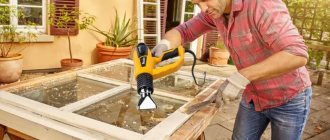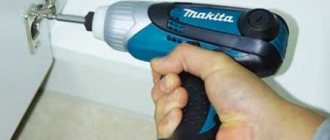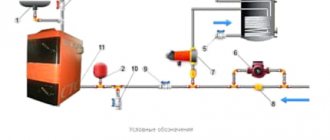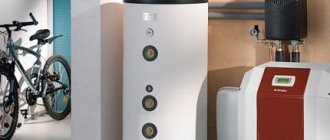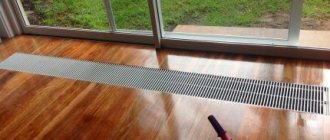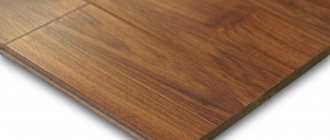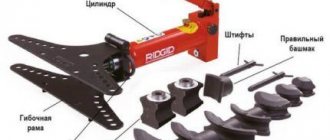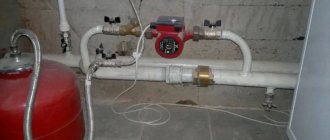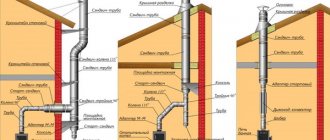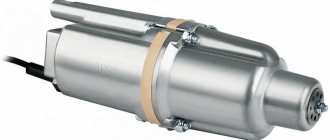- Brick
- Stainless steel kit elements
- Video about the importance of correct chimney installation
The outlet duct is one of the key elements of a room heating system. Through it, waste combustion products are discharged into the street. It can be made from different materials. We will look at what type of chimney is best for a solid fuel boiler, so that you understand how to organize the most reliable, efficient and safe design.
The correct design of the sleeve affects the stability of the draft and the efficiency of the heating device. An unsuitable pipe (too small a cross-section, with a rough internal surface) and improper installation lead to excessive soot clogging, and subsequently overheating, which leads to destruction and the release of harmful chemical compounds. The duration of operation without repair or replacement of individual elements is also very important. Therefore, already at the design stage it is necessary to clearly understand what to give preference to: stainless steel, ceramics or brick.
MATERIAL FOR BOILERS
As stated earlier, steam boilers with a pressure of up to 0.7 atm and hot water boilers with a heated water temperature of up to 115° can be made from cast iron or steel of any grade.
The rules issued by the State Boiler Inspectorate of the USSR Ministry of Power Plants and mandatory for all ministries and departments exclude these boilers from consideration. However, in order to ensure the durability of boilers and trouble-free operation, it is necessary to set some, at least minimal, requirements for the manufacture of this group of boilers. The Boiler Supervision Authority of the Ministry of Public Utilities of the RSFSR issued rules relating to steam boilers with a pressure of up to 0.7 ati and hot water boilers when heating water to 115°.
The following requirements apply to the materials used for the manufacture of low-pressure boilers.
Cast iron can be used no lower than grades SCh 15-32.
The boiler operating pressure is allowed to be equal to half the test hydraulic pressure at which it is tested when leaving the factory. The latter should be within the range of 6-10 ati for hot water boilers and 3 ati for steam boilers.
For the manufacture of steel boilers, carbon steel of any grade can be used.
For parts of the boiler located within the furnace, for example, for fire tubes, carbon steel of a quality not lower than MSt grades is required. 2 and MSt. 3.
Pipes that are the heating surfaces of boilers are allowed only seamlessly drawn.
When installing pipes for welding without the use of rolling, pipes welded with an overlap are allowed.
Welders who have passed tests and are approved for responsible welding work are allowed to perform welding work. The calculated tensile strength of the metal is taken to be equal to the minimum value of the tensile strength for steel of the accepted grade. If there is no information about the steel grade or its mechanical properties, then the calculated tensile strength is taken to be 32 kg/mm2.
Test hydraulic pressure for steel steam boilers is 3 atm, for steel hot water boilers - operating pressure plus 3 atm, but not less than 6 atm.
When making a boiler using riveting, the seam overlays and rivets should be of approximately the same quality as the base sheet material.
By choosing one or another type of seam and knowing how much weakening the sheet produces, the designer can accurately calculate the boiler based on the tensile strength values and specifying the corresponding reliability coefficient. Subsequently, the tightness of the rivet joints made is checked by a hydraulic test.
It is somewhat more difficult to obtain guarantees regarding the safety margin when manufacturing boilers using welding. A welding seam, in contrast to a riveted seam, consists not only of rolled material (which received its quality characteristics on samples cut from sheets), but also of cast material, and the casting itself is carried out by the welder during the process of making the seam. The quality of this cast material strongly depends on the source electrode metal (usually electric arc welding is used), on the skill and conscientiousness of the welder, on electrical equipment, etc. It is very difficult to check the quality of the deposited cast metal, since even with partial destruction of the weld, cutting out the corresponding samples, there will be no guarantee that the adjacent seam has the same quality indicators. Obtaining a high-quality weld is of significant interest. The design of the seam according to 244, with the quality of the cast material not exceeding the limits allowed for the base sheet material, makes it possible to bring the degree of weakening introduced by the seam to unity and, thus, obtain maximum metal savings. In this case, the walls of the drum will be stressed equally both within the seam and in the whole place. In a boiler with riveted seams, the wall thickness is taken based on the metal stresses in the longitudinal seam, weakened by the rivet holes, and therefore the stresses in the whole place are always slightly reduced, as a result of which material is overused.
Currently, rules have been developed for the use of welding in the manufacture of steam boilers with pressures above 0.7 ati. According to these rules, the electrode wire and the deposited metal (both separately) must be subjected to tensile and elongation tests, as well as impact strength .
The tensile strength in the deposited metal samples must be no less than the lower tensile limit for the base metal (welded sheets), the relative elongation must be no less than 18%. When testing for impact strength, the latter must be at least 8 kgm/cm2.
Such requirements for the weld allow, when calculating welded products, to accept for butt welds of the type shown in 244 a weld weakening coefficient equal to cp = 0.95.
High quality welds can only be achieved with proper organization of the technological process for manufacturing a welded boiler at a factory with a staff of highly qualified welders, using electrodes with a special thick coating that protects the cast metal from the harmful effects of air.
It is difficult to check the quality of the weld in a completed product. The most dangerous defect is lack of penetration - voids hidden inside the seam. To ensure complete reliability of the seam in such a critical structure as a steam boiler, it is planned to scan part of the seams using an X-ray machine or rays of radioactive substances.
Sandwich installation diagrams
You can make a chimney from modular sandwich pipes in 3 ways:
- The vertical part is located on the street, attached to the outer wall of the building. The horizontal chimney crosses the external fence, enters the house and is connected to the boiler (stove) pipe.
- The vertical smoke channel passes through the roof, descends into the boiler room and ends with a condensate collector. The heat generator is connected to it by a horizontal pipe.
- The trunk again crosses all roof structures, but is connected to the heater directly, without a pocket or horizontal sections.
Installation diagram of a wall chimney (left) and an internal duct passing through the roof (right)
The first option is suitable for ready-made houses of any type - frame, brick, log. Your task is to place the boiler against the outer wall, take the sandwich outside, and then secure the main pipe. In terms of financial and labor costs, this is the most profitable way to install a chimney.
Installing a modular system according to the second scheme is much more difficult. In a one-story house, you will have to go through the ceiling and roof slope, arranging fireproof cuts. In a two-story house, the piping will get inside the room and make you think about decorative cladding. But you won’t need to go around the roof overhang and secure the end of the chimney with guy wires.
The latter option is suitable for sauna stoves and fireplace inserts. The former get very hot and practically do not condense, the latter are hidden behind a fire-resistant plasterboard finish. To organize cooling of the sandwich channel, ventilation is provided in the space between the lining and the pipe. The photo above shows convection grilles that remove heated air from under the fireplace insert casing.
What kind of steel is used to make boilers?
A steam boiler operates under significant pressure, therefore it is a very responsible unit and must ensure reliable operation.
The higher the operating pressure and temperature at which the boiler operates, the more difficult the conditions are for the metal from which the boiler is made.
Basic requirements for boiler metal: 1) high heat resistance - the ability of the metal to maintain strength under conditions of high temperature and high stress; 2) high viscosity - the ability of a metal to maintain its mechanical properties under changing or repeated loads; 3) reduced susceptibility to aging - the ability of a metal to maintain its mechanical properties for a long time; 4) metal resistance against corrosion - under the influence of water and steam; 5) structural stability - the stability of the metal against structural changes that reduce its mechanical properties; 6) density, homogeneity of the metal structure, the absence of internal defects in it: caps, cracks and foreign inclusions.
Promotional offers based on your interests:
Therefore, boiler elements under pressure are made exclusively of steel (GOST 5520-62). This steel, in addition to high requirements regarding its chemical composition, is subject to more careful control and additional tests for impact strength and sensitivity to aging.
Sheet steel grades St. 2 and Art. 3 is intended for boilers and vessels operating at temperatures not exceeding 120°C. For boilers operating at higher temperatures, steel grades 15K and 20K are used.
Boiler parts that are not directly under pressure can be made from ordinary quality carbon steel (GOST 380-60) or high-quality structural carbon steel (GOST B 1050-60).
Advantages of a brick chimney
A chimney made of bricks is most often mounted on a stove, taking into account its advantages such as:
- the ability of the material to resist fire;
- duration of operation;
- ease of brick laying;
- no need for specialized maintenance;
- easy repair.
A brick chimney can withstand high temperatures, but relatively often gets clogged.
A brick chimney can also be characterized on the negative side: it is rough inside and therefore quickly becomes contaminated with soot, the accumulation of which negatively affects the draft force. The disadvantages of a brick chimney also include its heavy weight, which often requires placing the stove on a separate base.
Ꙭ Metals of boiler units - steel and cast iron - ikotel.info
The main metals used for the manufacture of boiler units are steel and cast iron.
Steel is used both relatively cheap - carbon steel, and more expensive - alloyed, i.e., one in which other metals are added in some quantity to improve the mechanical and physico-chemical properties. There are low-alloy steel, in which additives are contained in small quantities, not exceeding 0.5-1.0%, and high-alloy steel, in which a significantly larger amount of additives is added. Low-alloy boiler steel belongs to the class of pearlitic, and high-alloy boiler steel belongs to the class of austenitic steel.
Carbon steel is widely used in boiler making. The carbon content of this steel should not exceed 0.3% to avoid deterioration in the quality of welded joints due to air hardening during welding. The content of sulfur and phosphorus should not exceed 0.045% for each of these elements. The maximum temperature at which carbon steel can operate reliably and for a long time is 500 °C; exceeding it leads to a sharp intensification of scaling on the metal.
Alloying of boiler steel is intended to increase its strength and scale resistance at high temperatures. Chromium, molybdenum, nickel, vanadium, titanium, tungsten, niobium, manganese and boron are used as alloying additives, which are introduced in various combinations. Chromium is introduced into steel to increase its heat resistance, i.e., the ability to resist corrosion (scale formation) at high temperatures; the presence of 12-14% chromium in steel makes it stainless. Molybdenum is added to increase heat resistance, that is, to increase the tensile strength and yield strength of steel at high temperatures, as well as to improve its technological properties (weldability) and simplify heat treatment. Nickel increases the toughness of steel, its heat resistance and aging resistance. To increase creep resistance, i.e., reduce the yield strength of steel as a result of prolonged operation at high temperatures, vanadium and niobium are added to low-alloy chromium-molybdenum steel, and titanium and tungsten are added to high-alloy steel. The presence of manganese in steel in the range of 0.3-0.8% is determined by the technological requirements of the smelting process, and increasing the manganese content in steel to 0.9-1.5% aims to increase its strength. Alloying elements in steel grades are designated by letters of the Russian alphabet: B - niobium; B - tungsten; G - manganese M - molybdenum; N - nickel; P - boron; C—silicon; T - titanium; F - vanadium; X - chrome.
In the designation of high-alloy steel grades, numbers are placed behind the letters, which indicate the content of these elements in the steel as a percentage. The numbers before the letter designation indicate the carbon content of the steel in hundredths of a percent for low-alloy steel and tenths of a percent for high-alloy steel. If in high-alloy steel the amount of carbon is not limited by a lower limit with an upper limit of 0.09% or higher, numbers are not placed before the letter designation.
Semolina casserole with pumpkin and dried fruits
If children do not want to eat healthy pumpkin, you can hide it in a delicious semolina casserole. Dried fruits in the recipe are not only a “zest”, but also additional vitamins. If desired, they can be replaced with pieces of fresh fruit. For example, pear and apple, plum and peach are suitable. Any combination of fruits in semolina dough will be useful.
Ingredients:
- 200 g semolina;
- half a glass of milk;
- 50 ml filtered water;
- 25 g butter;
- 60 g pumpkin;
- 1 tbsp. l. Sahara;
- a pinch of salt;
- 100 g of any seedless dried fruit (dried apricots, prunes, raisins, dogwood);
- two raw chicken eggs;
- 50 g of premium wheat flour;
- 11 g baking powder.
Cooking method:
1. Rinse in warm water and soak dried fruits. Cut them into small pieces (except for raisins, do not cut them).
2. Cook semolina porridge in a saucepan. To do this, mix water with milk (take cold), add semolina and butter. Add sugar and salt. Stir and leave for now.
3. Peel the pumpkin and grate it on a fine grater or, using a blender, grind it into puree. Add to porridge.
4. Place the pan on the fire and, constantly stirring with a whisk or tablespoon, bring the porridge to a boil. Remove from heat and cool for a few minutes, stirring with a whisk.
5. Add eggs, flour and baking powder to the porridge. Stir until smooth and add dried fruits. Mix again.
7. Place the semolina porridge casserole dough on a baking sheet lined with paper or foil. If desired, grease it with additional oil.
8. Place the dish to bake until done.
You can serve semolina casserole with pumpkin and dried fruits with a glass of milk or a cup of tea. Casseroles prepared according to these recipes will become your favorite breakfast. It’s easy and simple to delight your loved ones with a new casserole recipe every day. Just write down the recipes and create amazing desserts from ordinary semolina!
Selection of boiler material
Chapter 6. MATERIALS AND BASICS OF CALCULATION OF STRENGTH OF STEAM BOILERS
Reliability of operation of a ship's steam boiler must be ensured at the design stage. It is known that its accident leads not only to the loss of ship speed, a decrease in electricity generation, but also to the creation of dangerous conditions for operating personnel caused by the filling of the engine room with hot gases and steam. Losses associated with a boiler failure far exceed its cost. Therefore, when designing boilers, strength calculations of heat-stressed parts and assemblies are performed.
The basis for the calculations is the science of strength - the strength of materials.
Under the influence of external forces, the boiler parts change their shape - they become deformed. During deformation, internal elastic forces arise in the material, acting between the particles and resisting external loads, that is, the stressed state of the material appears. The intensity of internal elastic forces is called stress. The strength of boiler parts depends on the magnitude of stresses arising during deformation, as well as on external conditions: temperature conditions; presence of corrosive media (water, steam, fuel combustion products); repeated, sometimes alternating loads that arise during starts, stops and changes in the steam output of boilers; vibration loads due to combustion pulsation and certain modes of movement of the steam-water mixture in pipes.
The reliability of the boiler is largely determined by the reliability of those parts that are under the influence of internal pressure. Therefore, the Rules of the USSR Register regulate the calculation of the strength of these particular boiler elements: collectors, bottoms, bottoms, heating surface pipes.
The USSR Register determines the grades, chemical composition, strength and ductility characteristics of steels from which ship boiler parts can be made.
The strength and ductility characteristics of steels include: tensile strength
, yield strength, elongation, contraction, impact strength.
All these characteristics for each steel grade depend significantly on temperature. For example, for carbon steel (Fig. 6.1), an increase in temperature above 350–400°C leads to a sharp decrease in and. It has been experimentally established that the strength characteristics of carbon steel at > 350°C not only decrease, but also become unstable. They decrease with increasing load holding time (Fig. 6.2). The loss of strength in this case is associated with the accumulation of internal microscopic cracks in the metal, or its creep
.
The creep process is characterized by the relative creep rate of the metal
Creep limit and long-term strength limit are used as criteria that determine the strength of steel at high temperatures and stress.
Creep limit
is called the voltage at which the creep rate is equal to a given one. For boiler parts, the creep rate does not exceed 2.75∙10 –11 s –1, which corresponds to a deformation of 1% for 10 5 hours of operation.
Long-term strength limit
is the stress that, at a given temperature, causes a metal to fracture after a certain period of time.
Since the stresses occurring in the boiler parts are mainly influenced by external load and temperature conditions, the determining condition for the selection of materials is the parameters of the steam produced by the boiler - pressure and temperature.
Other factors that also influence the choice of material only complement the requirements that must be met by the quality of the material used for individual boiler elements. Such additional properties that characterize the quality of boiler steels include heat resistance, endurance, heat resistance, corrosion resistance, the tendency of steel to relax stress and structural changes during long-term operation under conditions of high temperatures and external loads, and weldability.
Heat resistance
steel is characterized by the value of the long-term strength limit
at a given temperature; endurance,
or resistance of steel to destruction under the influence of repeated repeated loading, is the fatigue limit.
Metal fatigue is associated with the formation of microcracks in it and, as a consequence, brittle fracture of the part at stresses significantly lower than the tensile strength or even the yield strength. Usually . scaling,
can occur .
Heat resistance
is the ability of steel to resist oxidation in a high-temperature gas environment. It is expressed quantitatively by the temperature at which intense oxidation of steel begins – the temperature of scaling. For example, for carbon steel this temperature is 500°C.
Materials used in boiler construction must have high corrosion resistance
both in gas and steam environments, and in boiler water. The assessment of this material quality is determined by the corrosion rate measured in millimeters per year (mm/year).
, stress relaxation is possible in metals
, that is, a spontaneous drop in time in the stress of a deformed metal as a result of the transition of elastic deformation to plastic. Steels prone to relaxation are not used for the manufacture of boilers, since relaxation leads to a loss of strength and density of the rolling joints of pipes in the walls of the collectors.
Long-term operation of steel at high temperatures can cause significant structural changes in it: spheroidization and graphitization, which contribute to the softening of steel. Spheroidization is associated with a change in the shape of pearlite grains (lamellar pearlite in the steel structure takes a spherical shape), graphitization is associated with the decomposition of carbides into metal and graphite. Steels subject to softening at high temperatures are not recommended for use in heat-stressed boiler parts.
Brick pipe repair
To put the pipe in order, you can go in two ways: restore the masonry or perform lining - treat the channel inside with special means.
Reconstruction of masonry
In case of minor damage to the chimney masonry, they act quite predictably - instead of destroyed bricks, they install whole ones. To do this, the crumbled elements are carefully cleaned of the solution and removed. The empty cell is scraped out, after which a new element is placed in place of the taken brick, using a fresh mixture of clay and sand.
In case of minor damage to the masonry, it is restored by replacing individual bricks with new ones
Sometimes a situation arises when cracks appear in the pipe, through which moisture seeps in during heavy rains. In these cases, the outer surface of the pipe above the roof is primed and then plastered.
When the bricks in the masonry are damaged by more than 20%, partial repair of the chimney is out of the question. The smoke channel with severely damaged elements is completely dismantled to create a new masonry.
Video: one way to repair a brick chimney
Brickwork
Lining is an excellent way out of the situation if the problem is the loss of smoothness and strength by the chimney walls. To complete this task you need a mixture of Masan or Mordax. These compositions simplify the restoration of the chimney’s functionality and do not reduce its cross-section at all.
It will take only a few hours to complete the lining. The operation consists of the following steps:
- The area near the chimney is covered with film so that drops of a special composition do not stain the roofing material.
- Taking a brush with metal bristles, peel off fragments of bricks and soot from the inner walls of the channel.
Before lining, the brick channel is cleaned, achieving a smooth surface. - The channel, which has become completely clean, is wiped with a generously dampened rag.
- Using a special brush and winch, a special composition is applied to the inner walls. The mortar mixture should spread over the surface as the brush moves.
Masan lining mixture is used for repairing chimneys, as it is fire resistant - When the applied composition dries, the internal walls of the chimney are treated a second, and then a third time.
You may need several different brushes during the lining process. This is explained by the fact that the cross-section of the chimney in certain areas may not be the same. In general, the size of the brush should correspond to the parameters of the smoke channel.
If you comply with the requirements for the masonry process in a house or bathhouse, you can create a safe and durable chimney. A self-made structure can look no worse than the structures of real masters. If you have learned how to build chimneys with your own hands, then you can also make repairs of any complexity without outside help.
Metal boilers
The metal of steam boilers operates under very difficult conditions, as it is affected by the pressure and temperature of water and steam (steam-water mixture), the own weight of the lining and the uneven expansion of parts of the boiler unit.
The wall thickness of drums, collectors and pipes, dimensions of frame parts, etc. determined depending on the magnitude of the total load and the required safety margin, ensuring long-term performance of the parts. In addition to strength, the metal must have ductility (no brittleness), resist corrosion and have good weldability. Therefore, for the production of parts of boiler units (especially those that operate under pressure), high-quality steels are used.
All grades of boiler steel contain small, strictly limited amounts of carbon, manganese and silicon, as well as incompletely removed harmful impurities - sulfur and phosphorus. Steel containing only these elements is called carbon steel.
Carbon steel is used to make water economizers, screens and drums of boiler units operating at temperatures up to 450 °C. At temperatures above 450 °C, the strength of carbon steel decreases sharply. Therefore, for the manufacture of parts operating at higher temperatures, special heat-resistant steel is used, into which a small amount of molybdenum, chromium, nickel and other chemical elements is added to impart certain properties to the metal. This type of steel is called low alloy steel.
Low-alloy steel grades 12Х1МФ and 15Х1МФ are usually used to make radiation heating surfaces of direct-flow boiler units and steam superheaters (except for the outlet part), operating at temperatures up to 540 °C.
Both carbon and low-alloy steels are pearlitic steels, characterized by a dark surface.
The greatest heat resistance is possessed by chromium-nickel steel of the X18N12T austenitic class, also called stainless steel, in which the alloying additives of nickel and chromium reach 30% of the metal mass. Pipes of the outlet part of steam superheaters of high-pressure boiler units are made from this steel, the metal of which is exposed at a temperature of 570-660 °C. In addition to nickel and chromium, steel contains a small amount of titanium, which stabilizes the steel structure at high temperatures. This steel has a light, shiny surface. The main advantages of austenitic steel are its high heat resistance and ability to resist corrosion at high temperatures due to the high content of chromium (18%) and nickel (12%); hence the name - stainless steel. Austenitic steel is many times more expensive than pearlitic steel.
Let's see how individual elements of the chemical composition of steel affect its properties.
What is more profitable: making it yourself or ordering it?
At first glance, the design is quite simple, so it seems that you can buy material, arm yourself with tools, and save money. In this article we will not tell you how to properly make a chimney for a solid fuel boiler with your own hands, for the following reasons:
- To connect it you need to hire professionals. Because it is necessary to accurately think through the project, ensure the quality of the joints, and take into account all safety standards. Only specialists who have practical experience can guarantee all this.
- Only a product from a well-known and proven manufacturer in the market provides a guarantee of compliance with all fire safety requirements and the raw materials used.
Remember that shortcomings can result in improper operation of the heating system, fire, or backdraft. In an effort to reduce costs, do not put your life and the health of your loved ones at risk.
Carbon influence.
As the carbon content of steel increases, it becomes stronger and less ductile. An excessively high carbon content is harmful, since steel that is too hard and has low plasticity is less resistant to various mechanical deformations that occur, for example, when screen pipes are pinched when firing a boiler, and the weldability of steel also deteriorates.
For the manufacture of heating surfaces of boiler units operating at steam temperatures up to 450 °C, carbon steel grade 20 with a carbon content of up to 0.25% is widely used, and for the manufacture of boiler frames, carbon steel grade St. 3. Low-alloy steel contains even less carbon. For example, in steel grade 12Х1МФ used for the manufacture of steam superheaters of modern boiler units, the carbon content should not exceed 0.15%.
Fire safety technology
Installation rules are determined by SNiP 2 04 05-91U, NAPB A 01 001-2004, DBN B 2.5-20-200. According to them, the room under the heating unit must have an individual hose for removing combustion products, a separate ventilation system, and a sufficient level of natural and artificial lighting. The firebox must be located at a certain distance from walls and passages. It is important to make the floors fireproof; it is better if the supply of coal or firewood does not exceed the volume designed for one shift.
Only masters can take into account all these and many other points. Therefore, it is better to entrust the connection of a solid fuel boiler to the chimney and commissioning of the heating system to specialists. And in addition to this advice, we attach several more interesting thematic videos:
Video about the importance of correct chimney installation
Conclusion
A solid fuel boiler lacks a properly installed chimney. In this case, it will be able to work as efficiently as possible - burning all fuel and transferring the required thermal energy to the coolant.
Often homeowners choose a brick chimney, despite the fact that its laying requires a lot of effort and time, but it fully copes with its task over a long period of time. The video in the article will help you find additional information on this topic.

